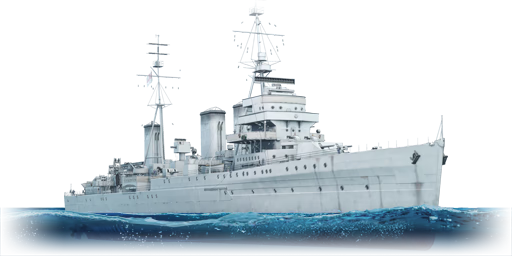

Bluewater Fleet
HMS Enterprise
III
Rank
AB
5.0
RB
5.0
Battle rating
Great Britain
Game nation
Light cruiser
Main role
21,000

Research
70,000

Purchase
General information
The HMS Enterprise is a British light cruiser. It was introduced in Update 1.83 "Masters of the Sea" as part of the British fleet closed beta test.
HMS Enterprise was the second of the so-called Emerald-class cruisers. Unlike her sister, the lead ship HMS Emerald, Enterprise was completed with a prototype twin 6-inch gun turret instead of two single 6-inch mounts. Designed during World War I for speed first and foremost, the two Emerald-class cruisers were still the fastest British cruisers in service at the outbreak of World War II, more than a decade after they were first commissioned.
Camouflages
Specification
Armour
Citadel
25 / 76 / 25 mm
Main fire tower
25 / 25 / 25 mm
Hull
25 mm (steel)
Superstructure
8 mm (steel)
Number of sections
8
Displacement
9,500 t
Crew
574 persons
Max speed
Forward
61527152 km/h
Backward
26223022 km/h
Primary armament
2 × 6 inch/45 BL Mark XII cannon
Ammunition
480 rounds
Reload
basic crew → aces
11.2 → 8.6 s
Vertical guidance
-5 / 40°
Turret Rotation Speed
Horizontal
65.165.1 °/s
Vertical
54.354.3 °/s
| Ammunition | Type | Armor penetration (mm) at a distance: | |||||
|---|---|---|---|---|---|---|---|
| 1000 m | 2500 m | 5000 m | 7500 m | 10000 m | 15000 m | ||
| HE | 53 | 53 | 53 | 53 | 53 | 53 | |
| SAPBC | 176 | 140 | 95 | 66 | 48 | 38 | |
| HE-TF | 53 | 53 | 53 | 53 | 53 | 53 | |
5 × Turret — 6 inch/45 BL Mark XII cannon
Ammunition
1,200 rounds
Reload
basic crew → aces
11.2 → 8.6 s
Vertical guidance
-5 / 40°
Turret Rotation Speed
Horizontal
86.886.8 °/s
Vertical
7676 °/s
| Ammunition | Type | Armor penetration (mm) at a distance: | |||||
|---|---|---|---|---|---|---|---|
| 1000 m | 2500 m | 5000 m | 7500 m | 10000 m | 15000 m | ||
| HE | 53 | 53 | 53 | 53 | 53 | 53 | |
| SAPBC | 176 | 140 | 95 | 66 | 48 | 38 | |
| HE-TF | 53 | 53 | 53 | 53 | 53 | 53 | |
Secondary armament
3 × Turret — 4 in/45 QF Mark V cannon
Ammunition
600 rounds
Reload
basic crew → aces
6.5 → 5 s
Vertical guidance
-10 / 80°
Turret Rotation Speed
Horizontal
86.886.8 °/s
Vertical
86.886.8 °/s
| Ammunition | Type | Armor penetration (mm) at a distance: | |||||
|---|---|---|---|---|---|---|---|
| 1000 m | 2500 m | 5000 m | 7500 m | 10000 m | 15000 m | ||
| HE | 17 | 13 | 11 | 11 | 11 | 11 | |
| SAP | 87 | 66 | 42 | 28 | 20 | 18 | |
| HE-TF | 20 | 20 | 20 | 20 | 20 | 20 | |
Anti-aircraft armament
2 × Turret — 4 × 40 mm 2pdr QF Mk.IIc automatic cannon
Ammunition
17,920 rounds
Belt capacity
56 rounds
Reload
basic crew → aces
7.8 → 6 s
Fire rate
200 shots/min
Vertical guidance
-10 / 75°
Turret Rotation Speed
Horizontal
1512.81512.8 °/s
Vertical
1512.81512.8 °/s
| Belt | Belt filling | Armor penetration (mm) at a distance: | |||||
|---|---|---|---|---|---|---|---|
| 10 m | 100 m | 500 m | 1000 m | 1500 m | 2000 m | ||
| HEF | 4 | 4 | 4 | 4 | 4 | 4 | |
6 × Turret — 20 mm/70 Oerlikon Mk.II autocannon
Ammunition
10,800 rounds
Belt capacity
60 rounds
Reload
basic crew → aces
5.2 → 4 s
Fire rate
450 shots/min
Vertical guidance
-10 / 85°
Turret Rotation Speed
Horizontal
7563.87563.8 °/s
Vertical
6555.36555.3 °/s
| Belt | Belt filling | Armor penetration (mm) at a distance: | |||||
|---|---|---|---|---|---|---|---|
| 10 m | 100 m | 500 m | 1000 m | 1500 m | 2000 m | ||
| HEF-T/AP-T | 34 | 32 | 26 | 21 | 18 | 16 | |
6 × Turret — 2 × 20 mm/70 Oerlikon Mk.II autocannon
Ammunition
21,600 rounds
Belt capacity
60 rounds
Reload
basic crew → aces
5.2 → 4 s
Fire rate
450 shots/min
Vertical guidance
-10 / 85°
Turret Rotation Speed
Horizontal
7563.87563.8 °/s
Vertical
6555.36555.3 °/s
| Belt | Belt filling | Armor penetration (mm) at a distance: | |||||
|---|---|---|---|---|---|---|---|
| 10 m | 100 m | 500 m | 1000 m | 1500 m | 2000 m | ||
| HEF-T/AP-T | 34 | 32 | 26 | 21 | 18 | 16 | |
Additional armament
Setup 1
8 × 533 mm steam turbined Mk.V torpedo
Economy
Repair cost
Basic → Reference
AB
4,666 → 6,322 

RB
5,961 → 8,077 

Crew training
20,000 

Experts
70,000 

Aces
590 

Research Aces
360,000 

Reward multiplier
AB / RB
330 / 600 % 

148 % 

Total cost of modifications
18,700 

37,600 

Talisman cost
1,200 

Research order:
Seakeeping |
|---|
Unsinkability | |
|---|---|
Firepower | ||
|---|---|---|
Rating by players
You must play more than 3 battles for the last week and more than 10 battles in a vehicle to rate it.
Like:
10
Armor protection:
Not enough ratings
Survivability:
Not enough ratings
Mobility:
Not enough ratings
Armament:
Not enough ratings
Balance:
Not enough ratings
Tips & Tricks
This space is currently empty
Do you know any interesting vehicle features?
Loading...
No articles about this vehicle yet
Become the first author and get rewards!
Write a guide, tell about interesting historical facts, make a tutorial or simply an interesting post.
No more content